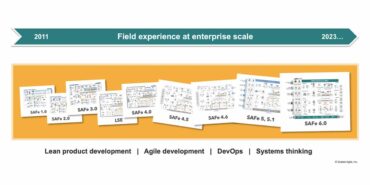Lean Portfolio Management: the key to getting back on track in 2022

Looking to get back on track after the events of 2021? Find out how to align strategy with execution using the Scaled Agile Framework (SAFe®) through Lean Portfolio Management. Apply lean and systems thinking to strategy and investment funding to enable business agility.
Within today’s environment, organisations are struggling to make decisions about what they should invest in, both for the year ahead and the longer term. The disruptions of 2020/21 – from the pandemic and racial conflicts to natural disasters and new workplace dynamics – have made it even harder for organisations to strategise and maximise investments with out-of-date project goals. For some it has been a costly realisation of the required technological/ digital footprint needed to survive the pandemic and the impact of not being flexible enough to adapt.
So how do organisations create more flexible and adaptive strategies that can materialise into execution?
As 2022 gains momentum, there are ways to help leadership teams deal with uncertainty and rethink how to bridge this gap between strategy and execution. An effective approach is by combining lean and systems thinking, both of which are foundations of SAFe’s Lean Portfolio Management (LPM).
Connecting strategy to execution
Lean Portfolio Management (LPM) helps leadership teams apply lean principles to connect strategy to execution. These practices help organisations to align on strategies more regularly through a series of agile-based cadenced events for leaders, providing transparent objectives and key results that will influence the initiatives the organisation prioritises. They also provide financial guardrails, facilitating dynamic budget adjustments to adapt to change.
This ‘rolling wave’ planning and budgeting approach is applied to several horizons of decision-making to accommodate strategic change. It also decentralises the decisions around how these initiatives are executed to the cross-functional teams tasked with delivering them, to ensure value delivery and ownership.
This transparency and greater alignment results in LPM becoming an enabler in increasing an organisation’s business agility. To gain business agility and realise the full value of an agile or digital transformation, business and technology teams must be aligned and remain aligned.
Combining Lean and Systems thinking
So how does LPM offer this pathway to increased agility?
By using lean principles originating out of Toyota and Six Sigma practices, the leadership of the organisation consider collectively where they should invest across all their business lines. Systems thinking encourages them to think holistically for the whole organisation and not to optimise any component parts.
This combination creates an organisational culture with a focus on building the organisation value stream for the customer, and development value streams to create products or services to meet the on-going customer demands. In order to create a consistent cadence of fast and flexible flow of high-value work, principles such as limiting work-in-process, reducing interruptions, and aligning the work to the organisation’s strategic outcomes are applied. This further accelerates the delivery of value and provides more frequent intervals to decide when to adapt, and thus achieve business agility.
Key elements of a Lean Portfolio Management environment
Here are some ways LPM differs from traditional portfolio management:
- Transparency – Uses roadmaps to visually show everyone the initiatives being driven by the objectives and key rules. Provides horizontal views to show intent as to why the work is required in today’s environment and what is being explored down the line. This can be a huge motivator to teams of teams and a key benefit of introducing LPM.
- Alignment – Informed decisions made based on feedback and adjusted to align with changing strategic needs (every quarter, as needed, based on new feedback).
- Participatory budgeting – Finances managed quarterly instead of annually. The value stream of work delivering what the organisation or customer requires is budgeted and recalibrated accordingly to meet the market or customer need.
- Investment reviews – Flexible outlook on initiatives and the external environment by reviewing the trends and the initiative pipeline for emerging solutions and iterating to ensure fit-for-purpose products or services are available as early as often.
With Lean Portfolio Management, leadership teams can set the overall direction by providing clarity to the vision and the strategic objectives and key results needed. Through an iterative and results-based approach, the use of LPM principles can then provide a cadence for aligned strategic investment and strong and aligned governance.
Keen to learn more about how to put Lean Portfolio Management into practice to benefit your organisation? Contact one of our experts today or join us on our next Lean Portfolio Management course.

About The Author
Quinn Dodsworth
Agile Learning Consultant and Facilitator
Quinn is a highly capable manager with a solid Agile transformation background backed by a Human Resource Learning and Development education. His industry experience includes seven years with the Commonwealth Bank of Australia and the Westpac Group specialising in change and productivity initiatives within various Agile transformations that underpin business learning and market demand.
Quinn’s focus is on driving new and innovative solutions to uplift business capability through the design and development of critical skills and knowledge across an organisation. These projects can range in size and complexity, with multiple internal and external stakeholders engaged to deliver a range of learning solutions to assist in Agile transformation.








